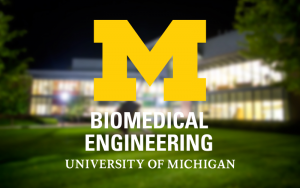Presented By: Biomedical Engineering
BME PhD Defense: Ahmet Emre
Bioinspired Nanocomposites for Structural Energy Storage

Energy storage is an integral part of life. Living creatures have developed a distributed and structural energy storage system to survive under various and sometimes extreme conditions. Similarly, energy storage is critical for modern life to power from small biomedical instruments to large aircraft. There are still several challenges against efficient and safe energy storage utilization due to the mechanical, chemical, and physical limitations of existing materials. Inspired by biological structures, we present multifunctional nanocomposites from aramid nanofibers (ANF), a nanoscale version of Kevlar, to address the safety and efficiency of various battery chemistries and enable structural energy storage to increase energy density. High mechanical properties of ANF suppress dendrite formation, and tunability with different copolymers and fabrication methods allow ANF-based nanocomposites to meet specific needs of different battery chemistries.
In the first part of this thesis, we engineered biomimetic solid electrolyte from ANF and polyethylene oxide for zinc batteries inspired by the cartilage structure. These strong nanocomposites can block stiff zinc dendrite and prevent short circuits over cycles. Resilience to plastic deformation and damage while having no leaking fluids or cracks is essential for the safety of, for instance, electrical vehicles employing such batteries. These load-bearing batteries can be used as a structural component and increase energy density by simply avoiding inactive parts. As a proof of concept, we utilized this battery on a commercial drone as an auxiliary energy storage unit to extend flight endurance by about 20%.
The second part of the thesis addresses a specific polysulfide shuttle problem in lithium-sulfur batteries utilizing bioinspired ANF nanocomposites. Mimicking ion channels on the cell membrane, we engineered biomimetic nanochannels (1nm diameter) for selectively allowing lithium-ion passage while physically blocking lithium polysulfide species (>2nm) on the cathode side. Selective ion transport through nanochannels is also modeled by finite element analysis, COMSOL. These ion channels allow us to reach >3500 cycles.
In addition to previous solid and liquid electrolyte systems, here in the last part of the thesis, we present a tunable quasi-solid polymer electrolyte to take advantage of both electrolyte features while minimizing their individual risks and drawbacks. Similar to the kidney filtration system, specifically the glomerular basement membrane, this gel electrolyte filters ions depending on their size and charge. Selective permeability and regulated ion transport provide safe and stable charge/discharge cycles. High mechanical properties keep functionality under extreme conditions, including high temperature and nail penetration. We integrated pouch cells in various prototypes to show practical utilization of our structural batteries, including health monitoring devices, robotic prosthetics, and electric vehicles.
Taken together, mimicking structural and functional properties of multifunctional biological materials, i.e., cartilage, we present a novel multifunctional nanocomposite system that can be tailored to the specific needs of numerous structural energy storage applications.
Date: Monday, August 9, 2021
Time: 2:00 PM
Zoom: https://umich.zoom.us/j/92570283886
Chair: Prof. Nicholas Kotov
In the first part of this thesis, we engineered biomimetic solid electrolyte from ANF and polyethylene oxide for zinc batteries inspired by the cartilage structure. These strong nanocomposites can block stiff zinc dendrite and prevent short circuits over cycles. Resilience to plastic deformation and damage while having no leaking fluids or cracks is essential for the safety of, for instance, electrical vehicles employing such batteries. These load-bearing batteries can be used as a structural component and increase energy density by simply avoiding inactive parts. As a proof of concept, we utilized this battery on a commercial drone as an auxiliary energy storage unit to extend flight endurance by about 20%.
The second part of the thesis addresses a specific polysulfide shuttle problem in lithium-sulfur batteries utilizing bioinspired ANF nanocomposites. Mimicking ion channels on the cell membrane, we engineered biomimetic nanochannels (1nm diameter) for selectively allowing lithium-ion passage while physically blocking lithium polysulfide species (>2nm) on the cathode side. Selective ion transport through nanochannels is also modeled by finite element analysis, COMSOL. These ion channels allow us to reach >3500 cycles.
In addition to previous solid and liquid electrolyte systems, here in the last part of the thesis, we present a tunable quasi-solid polymer electrolyte to take advantage of both electrolyte features while minimizing their individual risks and drawbacks. Similar to the kidney filtration system, specifically the glomerular basement membrane, this gel electrolyte filters ions depending on their size and charge. Selective permeability and regulated ion transport provide safe and stable charge/discharge cycles. High mechanical properties keep functionality under extreme conditions, including high temperature and nail penetration. We integrated pouch cells in various prototypes to show practical utilization of our structural batteries, including health monitoring devices, robotic prosthetics, and electric vehicles.
Taken together, mimicking structural and functional properties of multifunctional biological materials, i.e., cartilage, we present a novel multifunctional nanocomposite system that can be tailored to the specific needs of numerous structural energy storage applications.
Date: Monday, August 9, 2021
Time: 2:00 PM
Zoom: https://umich.zoom.us/j/92570283886
Chair: Prof. Nicholas Kotov